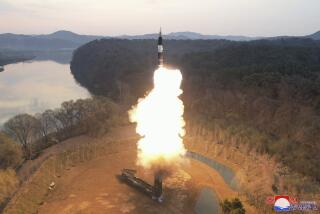Crucial Radar Failed Missile Defense Test
- Share via
Despite initial assessments that Saturday’s missile defense test was a success, the Pentagon acknowledged Tuesday that a prototype radar was unable to tell ground controllers whether a kill vehicle had destroyed its target.
The radar, a critical element of the controversial national antimissile system, falsely reported that the interceptor had missed the dummy warhead. Independently, several sensors set up to monitor the test showed a hit.
The Pentagon, which confirmed the radar problem, downplayed the incident as a computer programming glitch that easily could be fixed for the next interceptor test expected in the fall.
“The software they installed just couldn’t keep up with the information that was coming out,” said Lt. Col. Rick Lehner, a spokesman for the Pentagon’s Ballistic Missile Defense Organization. “It wasn’t a major problem. We just need to make some modifications.”
Defense analysts, however, said they were troubled by the radar’s failure to make the so-called hit assessment. In addition to identifying real warheads from decoys, the $100-million prototype radar is supposed to help ground controllers determine whether they should launch backup interceptors in case the first failed to hit their targets.
“If you are not able to make a kill assessment, you continue to have interceptors fired at targets that you’ve already hit,” said John Pike, a defense policy analyst with GlobalSecurity.org, a nonpartisan think thank.
Other analysts said the incident illustrated the immense complexity involved in developing the nation’s most ambitious and costly military program, which some estimate could cost as much as $300 billion.
“I think it indicates one of the big challenges that the program is going to face,” said Philip E. Coyle, former Pentagon chief for testing and evaluation. “I think it’s fixable, but the question will be what about when you get into a more difficult engagement. It’s going to take a long time to sort through all this stuff.”
Pentagon officials said Tuesday that the radar system failure was not disclosed immediately after the test because it was “not a major concern.”
Initial statements from the Pentagon after Saturday’s test indicated success when the so-called kill vehicle located and destroyed a dummy missile warhead in space about 144 miles above the central Pacific Ocean.
The 120-pound interceptor, launched atop a missile from Kwajalein Atoll in the Marshall Islands, was able to find the target flying at more than 16,000 mph and pulverize it in a blinding flash of light.
It marked the second time in four tries since October 1999 that an interceptor had hit its target, and some analysts predicted it would bolster the Bush administration’s push to accelerate development of a missile defense shield.
The first such test led to a successful interception, though critics contended that the test had been oversimplified. In a second test, in January 2000, the kill vehicle missed its target after a clogged cooling pipe disabled its infrared sensors, which are used to distinguish the warhead.
In the third test, last July, the kill vehicle failed to separate from the booster. Subsequent analysis showed that a software failure was part of the problem in this mishap. Two months later, then-President Clinton, citing test failures, postponed a decision about whether to go ahead with plans for a limited, land-based antimissile system.
The test involves huge financial stakes, for taxpayers and for the defense companies that are keenly interested in the biggest Pentagon development program now underway. Each test costs about $100 million, and the Pentagon has proposed to increase its schedule from one or two major flight tests a year to as many as eight.
Congress is debating an administration missile defense plan that calls for a 57% hike in program spending to about $8.3 billion a year and accelerate testing of technologies that could become part of a layered antimissile system including airborne and space-based lasers.
“We believe we have a successful test in all respects at this time,” Air Force Lt. Gen. Ronald Kadish, director of the Ballistic Missile Defense Organization, said shortly after the test.
But Air Force officials keeping tabs on the prototype “X-band” radar, also based at Kwajalein, weren’t so sure.
According to the Pentagon, the radar was able to help track the target and guide the kill vehicle to the dummy warhead, successfully distinguishing a balloon decoy that was launched with the target.
An early-warning satellite detected the launch from Vandenberg Air Force Base and alerted a missile defense command center at Colorado Springs, Colo., where battle managers then cued the prototype radar on Kwajalein 4,600 miles away. About 20 minutes later, the kill vehicle, using its own sensors and aided by the radar, slammed into the target.
But the Pentagon’s Lehner said the radar was unable to process all the information generated from the debris field.
“When it swept to do a kill assessment, it just couldn’t process all the information quick enough,” he said. “The information was locked out, and it came back with a miss message.”
The actual confirmation of the kill came from eight sensor systems based on a satellite, a specially equipped 747 jet and on the ground. In a future missile defense system, however, those added sensors would not be available.
The prototype radar is one-third the size of a production model that is under development by Raytheon Corp. at its Bedford, Mass., operations. Under current plans, the full-scale radar, encased in a dome and costing about $1 billion, would be constructed in Shemya, Alaska.
The X-band radar would be one of the most powerful radars in the world. It would be able to discriminate and determine very precisely the number, characteristics and movements of objects in a cluster in space thousands of miles away. The radar for instance can distinguish a golf ball 2,400 miles away, or the distance between Washington and Seattle, according to Pentagon officials.
In Saturday’s test, Pentagon officials contend the radar was too sensitive and tried to track all the debris, overwhelming the computer processing the data.
But Raytheon officials differed in the assessment of what went wrong, saying the radar’s computer was overloaded with information just seconds before the intercept causing it to lapse into a “coast” mode.
When the intercept did occur, it was not able to relay the information instantly, although it was able to determine that the target had been hit during a review of the test.
“We are very pleased with the performance of the radar. It met all of its test objectives,” said Mark Day, a Raytheon spokesman. “However, as a result of the test, we learned that there were some minor problems which are solvable. This is why we do tests.”
(BEGIN TEXT OF INFOBOX / INFOGRAPHIC)
The Radar’s Role
The proposed missile defense shield would offer overlapping detection systems to track, then destroy, an incoming missile. The atoll-based X-band radar, which failed in Saturday’s test, would be the military’s final set of eyes. How Saturday’s test took place:
*
How X-Band Radar Works
A. Tens of thousands of compressed, coded signals are merged and sent out in pulses.
B. The echoes returned from objects reveal the size, shape and trajectory of the objects.
C. On Saturday, the returning echoes overloaded the system.
Sources: Defense Department, Associated Press
More to Read
Sign up for Essential California
The most important California stories and recommendations in your inbox every morning.
You may occasionally receive promotional content from the Los Angeles Times.













